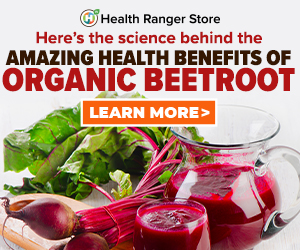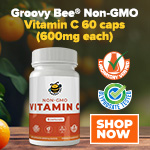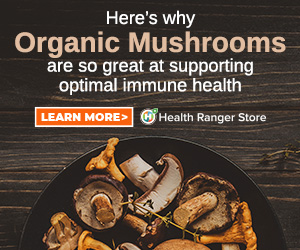
Local and organic food, farming: Here's the gold standard
Monday, February 28, 2011 by: Ronnie Cummins
Tags: local food, organic farming, health news
- Newly released JFK files reveal Pentagon's role in creating Lyme disease and covid in the same lab
- Trump nominates VACCINE ZEALOT Susan Monarez to lead the CDC, sidelining RFK Jr.'s reform efforts
- BEWARE: USDA allows genetically engineered vaccines to infiltrate organic food production
- Obama accused of laundering USAID funds to fuel global protest movements, regime change operations
- Festive flavors: The sweet history, nutritional profile and health benefits of pecan pie
- Dr. Mike Yeadon releases 15-minute testimony - WATCH - about genocidal intent of COVID “vaccines”
- Analysis: The coming economic collapse, a mass uprising and Trump's three secret weapons to halt the growing revolt
- Big Pharma's media takeover: How drug companies bought the news - and your health
- Elon Musk: Aliens could be here on Earth RIGHT NOW
- Survival 101: Effective EMF blocking techniques
- Trump reverses course on Gaza plan, says “nobody is expelling Palestinians”
- California's social media censorship law struck down: A victory for free speech or a threat to online safety?
- Reclaim your health: How midlife exercise reverses years of inactivity
- Rep. Nancy Mace introduces bill to ban biological males from female facilities on federal property
- Big Pharma's $8 Billion bribery scheme exposed: how doctors are pushed to prescribe junk science, not heal
- HUGE: Putin claims 2020 election fraud in U.S. sparked Ukraine war, calls for peace talks with Trump
- Chris Rufo finally reveals abuse liberals unleashed on his wife and young kids...
- RFK Jr.'s SSRI antidepressant investigation sparks liberal meltdown, exposes Big Pharma's dangerous game
- Elon Musk: Aliens could be here on Earth RIGHT NOW
- EPA advisor admits the agency is funneling billions to climate groups ahead of Trump’s return to White House
- Trump reverses course on Gaza plan, says “nobody is expelling Palestinians”
- Reclaim your health: How midlife exercise reverses years of inactivity
- A lack of integrity in Academia: Harvard professor found GUILTY of fraudulent research to promote CRT theory
- Space war brewing? Russia threatens to destroy Starlink satellites
- Big Pharma's $8 Billion bribery scheme exposed: how doctors are pushed to prescribe junk science, not heal
- Mike Adams Sermon 66: God will DESTROY ISRAEL for its wickedness
- Rep. Nancy Mace introduces bill to ban biological males from female facilities on federal property
- Survival 101: Effective EMF blocking techniques
- 5 Simple steps to boost your brainpower: How to strengthen executive function in a distracted world
- Historian warns Israel may be entering an “IRREMEDIABLE DECLINE”
- Florida takes a stand: DeSantis proposes permanent ban on mRNA vaccine mandates
- RFK Jr.'s SSRI antidepressant investigation sparks liberal meltdown, exposes Big Pharma's dangerous game
- New York politicians push bill allowing governor to indefinitely detain the unvaccinated on a whim
- Sales of survival bunkers rise following Russia’s use of the Oreshnik hypersonic ballistic missile
- Pilots report mysterious lights 'moving at extreme speeds' across Oregon skies
- Newly released JFK files reveal Pentagon's role in creating Lyme disease and covid in the same lab
- EPA advisor admits the agency is funneling billions to climate groups ahead of Trump’s return to White House
- The Health Ranger releases “Vaccine Zombie” song and music video, using AI-animated zombies for the music video
- The pandemic as a tool for INDOCTRINATION: Understanding “The Indoctrinated Brain” by Dr. Michael Nehls
- California's social media censorship law struck down: A victory for free speech or a threat to online safety?
- Dr. Mike Yeadon releases 15-minute testimony - WATCH - about genocidal intent of COVID “vaccines”
- Congratulations to the FULLY UNVACCINATED as you resisted the COVID-19 PROPAGANDA MACHINE fueled by over $100 BILLION
- Mike Adams releases country western hit single: Goin’ Back in Time is Comin’ Home
- RFK Jr. clears key hurdle: Sen. Susan Collins backs controversial HHS nominee, signaling a new era for health policy
- Mike Adams releases music poetry sensation: A Child of God
- Mike Adams releases new song and music video: Nothing More Disgusting Than a Globalist
- Unpacking the Lies That We’ve Been Fed – new song and music video released by Mike Adams, the Health Ranger
- Trump administration takes on global censorship: A new frontier for free speech advocacy
- Florida takes a stand: DeSantis proposes permanent ban on mRNA vaccine mandates
- “Why we influenced the 2020 elections”: Facebook files reveal the coordinated effort to bury the Hunter Biden laptop story
- Ex-FBI Chief EXPOSES disgraceful government coverups of Oklahoma City Bombing, Kennedy assassinations, 9/11 WTC, and "Terrorism" as plot to destroy Constitution
- Michigan sheriff announces criminal investigation into 2020 election crimes, Dominion Voting Systems
- Israeli soldiers accused of even more torture and abuse in the West Bank
- Federal judge backs Trump's mass firings, clearing path for government downsizing
- Red Cross issues warning to stop blood plasma donations from vaccinated people
- Scientists confirm: GENIUS brain function can be spontaneously unleashed in humans without any apparent cause
- EPA advisor admits the agency is funneling billions to climate groups ahead of Trump’s return to White House
- HYSSOP: What research reveals about the health benefits of this ancient holy herb
- Two containers with completed ballots fall out of truck in Florida
- Fully vaccinated about to see “tsunami” of illness and death, warns virologist
- Today I asked our AI language model “Neo” about which phytonutrients or phytochemicals can block the spike protein related to SARS-CoV-2 … Here is what it answered…
- Global leaders unite to clamp down on “misinformation” with UN-backed Cascais Declaration
- BREAKING: 2025 NDAA authorizes mandatory military draft of WOMEN across America… as Pentagon pursues global NUCLEAR war with both Russia and China at the same time
- Michael Yon warns of a ZIONIST TAKEOVER in Trump’s second administration
- BOMBSHELL: DNA testing kits are a SCAM to develop ethnic-specific bioweapons
- Ozempic and Wegovy weight loss drugs are injectable LIZARD VENOM PEPTIDES that may unleash a devastating wave of organ failure… side effects align with symptoms of SNAKE BITES
- Israeli soldiers accused of even more torture and abuse in the West Bank
- These 13 countries just signed an agreement to engineer a global FAMINE by destroying food supply
- NASA admits that climate change occurs because of changes in Earth’s solar orbit, and NOT because of SUVs and fossil fuels
- RFK Jr. clears key hurdle: Sen. Susan Collins backs controversial HHS nominee, signaling a new era for health policy
- Sermon 30: How Jesus reveals Caesar’s FAKE CURRENCY and FALSE AUTHORITY
- Coriander seeds: Ancient medicine backed by modern science
Those who espouse local food are now called "locavores." But, beyond the greenwashing and co-opting of the term by Wal-Mart, the supermarket chains, and factory farms and feedlots, what does "local" food and farming really mean? What is the impact of non-organic local food and farming on public health, nutrition, soil, water, marine life, biodiversity, and climate?
Jessica Prentice coined the term "locavore" for World Environment Day in 2005 to promote local eating, and local consumption in general. Her goal was to challenge people to obtain as much food as possible from within a one hundred mile radius. Her success was more than she imagined. In 2007 the New Oxford American Dictionary selected "locavore" as its word of the year. Local had arrived!
Then, highly respected author Barbara Kingsolver published Animal, Vegetable, Miracle, emphasizing the value of eating locally, and the concept spread like wildfire. (3) While the eat local/buy local concept is increasingly popular, looking beyond the label or the marketing claims, it is obvious that "local" is a rather fuzzy concept, lacking in most cases a concrete definition or a set of principles and guidelines.
By contrast, the organic system of food production has legal definitions, a handbook of rules, permitted and prohibited substances, acceptable practices, an inspection process, and labels to guide consumers. Local has none of these guidelines, rules, inspections or protections. It has the cachet of popularity without any guarantee of safety or sustainability.
Some chemical farmers, and even poultry, egg, pork, dairy, or beef operators feeding their animals genetically modified (GMO) grains, claim that local is better than organic, because it stimulates the local economy and reduces the distance (food miles) that food travels between the farm or feedlot and your table. But does so-called local farming, utilizing toxic pesticides, GMO seeds and feed, chemical fertilizers, and animal drugs mean that the food is safe and sustainable? Obviously not. We believe that there shouldn't have to be a choice between local and safe organic; but rather that consumers should look for food that is not only local or regionally produced, but food that is also organic and therefore safe and sustainable. Local and chemical, or local using GMO seeds and feed, is nothing more than greenwashing. Organic and local is the new gold standard!
The locavore phenomenon brings up several important concerns including: food miles, chemically grown food, greenhouse gas emissions, factory farming, genetically engineered animal feed, and the value of organic labeling. All of these crucial issues relate to the central question: what should be in your market basket?
Does Local Mean Safe?
Despite the increasing popularity of the eat-local movement, many people do not understand that "local" does not necessarily mean that food is organic or even safe. Chemically grown foods produced locally may be cheaper than organic and may aid the local economy, but they pollute the ground water, kill the soil food web, decrease the soil's ability to sequester climate-destabilizing greenhouse gases, broadcast pesticides into the air, poison farmworkers, and incrementally poison consumers with toxic residues on their foods. "Local" pesticides, GMOs, and chemical fertilizers are just as poisonous as those used in California, Mexico, Chile, or China.
Frequently, local chemical farmers claim that they only use "less toxic" pesticides or herbicides such as Monsanto's Roundup. Unfortunately, "less toxic" is a dangerously relative term! Roundup is a powerful weed-killer, and is now sprayed so heavily on the nation's 150 million acres of genetically engineered crops that it is poisoning our water supplies, killing the soil, and creating superweeds that can only be killed with super-toxic herbicides such as 2,4 D, arsenic and paraquat. Farmers in the U.S. have used everything from arsenic, lead, cyanide, fluorine, DDT, and nerve poisons since the 1860s, and they still use massive amounts. More than 80 percent of all the pesticides currently used in vegetable, fruit, and flower production are nerve poisons that were used on insects and also on concentration camp victims during the first and second World Wars.
Organophosphate pesticides or nerve poisons have been linked to Attention Deficit Hyperactivity Disorder (ADHD) in children. Organophosphate nerve poisons were found in the urine and saliva of Seattle preschool children who were eating conventional (chemical) and local food. When the kids stopped eating chemical food and ate organic food the organophosphates disappeared from their saliva and urine. When the children returned to the chemical diet, the nerve poisons showed up in their urine and saliva again. (4) Nerve poisons, whether they are used on foods that are locally, nationally, or internationally produced and distributed, are dangerous hazards, especially for growing children and at-risk populations. They need to be driven off the market as soon as possible.
Does "Pesticide Free" Mean Safe or Sustainable?
Often, growers at farmers markets will say, "I don't use pesticides, I only use chemical fertilizers." Sadly, what many people do not realize is that chemical fertilizers are extremely hazardous. A high percentage of these fertilizers seep into our wells and municipal drinking water, or else run off into our streams, rivers, and finally end up in the ocean. Two-thirds of the nation's drinking water is contaminated with hazardous levels of nitrogen fertilizer. Non-organic farmers and feedlot operators are literally poisoning us and our children with the collateral damage of chemical fertilizers. High nitrogen and phosphorous levels in rivers and oceans kill fish and other marine wildlife. When this enormous amount of excess nitrogen enters the ocean it causes dead zones and oceanic acidification.
Some "pesticide free" growers will argue that since they only use chemical fertilizers, their produce is cleaner. Their food may not have high pesticide residues. But, remind them that "cleaner" isn't clean! And inform your local chemical farmer that their toxic fertilizer is polluting our drinking water, trashing the oceans, killing the soil's ability to sequester greenhouse gases, destabilizing the nitrogen cycle of plants, and emitting billions of pounds of deadly greenhouse gases every year.
Synthetic nitrogen fertilizer is perhaps the most potent greenhouse gas emitter in the U.S. To produce each pound of fertilizer, 6.6 pounds of nitrous oxide (N2O) are emitted. Nitrous oxide accounts for a full ten percent of all climate-destabilizing greenhouse gases.
Nitrous oxide is extremely hazardous. It depletes the ozone layer in the upper atmosphere (thereby increasing skin cancer for humans). It increases ozone pollution levels at the ground level (fueling the current epidemic of asthma and respiratory diseases). Poisonous nitrate fertilizers leaching into our rural wells and municipal drinking water supplies (where it combines into a super-toxic brew with pesticides) are a biological time bomb, a major cause of cancer, infertility, hormone disruption, and birth defects.
Perhaps most deadly of all, nitrate fertilizer kills our living soils and soil microorganisms, decreasing their ability to sequester (through plant photosynthesis) excess greenhouse gases in the soil. Even after a century of industrial farmers dumping hundreds of billions of pounds of chemical fertilizers on farmlands, our living soils still contain two to three times as much carbon as the atmosphere, with the practical capacity to clean and safely sequester a considerable amount of greenhouse gases over the next 40 years. In other words, our living soils can save us - but only if we stop the widespread use of nitrate fertilizers, GMO crops, and pesticides, and replace these deadly chemicals and mutant organisms with organic compost, compost tea, and cover crops, augmented by the biological power and fertility generated by organic, carefully planned, high-density rotational grazing of animals.
The energy-intensive manufacturing of nitrate fertilizers requires the use of massive amounts of natural gas, a resource in short supply, that will increasingly be needed to take us through the transition from fossil fuels to alternative energy. We can no longer afford to waste natural gas in order to uphold the profits of Cargill, Monsanto, and Food Inc. We can no longer afford to have chemical-intensive food and farming greenwashed as "local."
U.S. non-organic farmers used an average of 24 billion, 661 million pounds of synthetic nitrogen fertilizer per year from 1998 to 2007. That means that more than 162 billion, 762 million pounds of nitrous oxide (N2O) are released each year in the process of manufacturing that fertilizer. ( 5) Also released is the CO2 from transporting the fertilizer. Since 70% of synthetic nitrogen is imported, the transportation cost is increasingly higher each year. Beyond production and transportation emissions, enormous quantities of N2O get released when the 24.66 billion pounds of synthetic nitrogen is applied to farmland every year. Nitrous oxide is 310 times more damaging as a greenhouse gas than carbon dioxide. Every year, U.S. farmers use enough synthetic nitrogen to fill more than 12,330 railroad boxcars with a capacity of 200,000 pounds each.
Consequently, farmers and supermarkets that tout their products as local and pesticide-free while still using synthetic fertilizers are engaged in greenwashing. Non-organic farms poisoning the environment with chemical fertilizers are a far cry from safe or environmentally friendly, even though they promote themselves as pesticide-free and local.
"Local" Factory Farms and CAFOs: Destroying Public Health and Climate Stability
According to Wal-Mart and Food Inc.'s definition of local (anything produced within a 400-mile radius), meat, dairy, and eggs, reared on a diet of GMO grains, slaughterhouse waste and antibiotics, qualify as "local." According to the USDA, the majority of the nation's non-organic meat, dairy and eggs are now produced on massive factory farms, euphemistically called Confined Animal Feeding Operations (CAFOs). (6) CAFOs are typically overcrowded, filthy, disease-ridden, and inhumane, not only for the hapless animals imprisoned inside their walls, but also for the typically non-union exploited immigrant workers who toil in these hellish facilities. According to the EPA, the legal definition of a CAFO is a farm or a feedlot where large numbers of animals are confined and reared: beef - 1000 head; dairy - 700 head; swine - 2500 pigs weighing more than 55 lbs; poultry - 125,000 broilers or 82,000 laying hens or pullets. (7)
Unfortunately, meat, dairy, or eggs coming from CAFOs in North America are not required by law to be labeled as such. Greenwashing CAFO products as "natural" or "local" is a major source of profits for Wal-Mart, Cargill, Conagra, Perdue, Land O' Lakes, Kraft, McDonalds, KFC, Monsanto and chemical/GMO farmers and ranchers. Organic consumers, farmers, and retailers need to educate the public about the hazards of factory farms and CAFOs. These animal factories, where GMO feed and drugs are force-fed to most of the nation's livestock and poultry, are not only poisoning consumers, but are also generating massive amounts of climate-destabilizing greenhouse gases, especially methane, which is 72 times more destructive per ton than CO2. Methane (CH4) pollution is responsible for approximately 14 percent of human-induced global warming.
Where does methane pollution come from? Methane pollution mainly comes from factory farms and the overproduction of non-organic meat, dairy, and eggs; from throwing hundreds of millions of tons of rotting food, paper, and lawn wastes into landfills (instead of composting them for use on farms, ranches, and gardens); and the destruction of wetlands for shrimp and fish farms, industrial agriculture, chemical-intensive rice farming, and urban development or sprawl.
How do we get rid of excess, climate-destabilizing methane? By purchasing organic foods, especially those produced by family farmers and ranchers in our regions, and by increasing consumer awareness that it is unhealthy and inhumane to purchase factory farm foods. It is becoming increasingly clear that buying or consuming meat, dairy, or eggs that come from a factory farm or CAFO is an ethical abomination and a climate crime. While calling for a boycott of factory-farmed products, we must deliver the positive message that the organic, humane, healthy, food-producing small farms and ranches of North America are actually greenhouse gas sequestration centers, arguably our most important allies in cooling off the planet.
Millions of consumers are still in the dark about how "conventional" foods - especially the cheaper brands of animal products, processed, fast, and fake foods - are produced. We must educate the public about the need to fight for Truth-in-Labeling so that CAFO products, derived in great measure from Monsanto's GMO crops, are no longer greenwashed as "local" or "natural."
Food Miles and Greenhouse Gas Emissions
Food miles are the average miles that food travels from the farm to the consumer. Since more than 80 percent of the U.S. grocery purchases are now processed foods, a huge percentage of the carbon or fossil fuel footprint of industrial agriculture comes from transporting factory farm crops or animals to the processing plant or slaughterhouse and then transporting these processed foods from the processing plant to the dinner table via the supermarket. By reducing the processed foods in our diet we can greatly reduce the food miles or carbon footprint for which our households are responsible, since the shorter the distance food travels, the lower the greenhouse gas emissions.
Part of the locavore ethic is to get people to eat from their own foodshed, to save energy, reduce greenhouse gas emissions, and stimulate the local economy. But real "local" is also about stimulating a return to in-home food preparation, an appreciation for taste, and the joy in cooking - and eating. As folks begin to appreciate the taste of locally grown fresh organic foods, their dependence on processed foods from afar usually dwindles.
The 20 percent of the U.S. diet that is not processed food includes fresh fruits and vegetables, dairy products, farm raised meats, eggs, whole grains, cold pressed oils, raw honey, syrup, natural sugars, etc. Though only 20 percent of the total food budget, the sales of non-processed food are huge! Unfortunately, production of non-processed foods is largely regional with production concentrated on the southern half of both coasts and the southwest. So, even a majority of the fresh foods come from afar. This requires lots of trucking and refrigeration to get the food to local markets the across the country.
"Fresh food miles" indeed contribute to the high CO2 emissions from the U.S. food system, but these whole foods are certainly not the major greenhouse gas contributor in our food system. That dubious honor belongs to factory-farmed meat, eggs, and milk, which generate 30 to 50 percent of all of the U.S. greenhouse gases, more than industry and fossil fuels combined. (8)
Fortunately, locally and nationally, farmers have worked out strategies of how to grow fresh foods in the middle of the winter with better technology and a minimum of heat, even in extremely cold places like Maine, Vermont, Minnesota, and Montana. Consequently, farmers and consumers are growing and storing food throughout the year so that they are not responsible for so many food miles on their tables.
Our thesis is that a majority of our food miles could be chopped off if we prepare more of our food from local ingredients. But, that begs another question. What kind of local ingredients?
Chemical and Local versus Organic and Local
Some growers and brokers argue that local, chemically grown is better than fresh organic, because so much that is organic travels long distances from the two coasts. If they are talking about comparing supermarket fresh organic with fresh chemically grown local, we should still choose supermarket organic, because, whether they are used locally or nationally, pesticides and fertilizers are more dangerous and deadly to your health and the health of the environment than chemically-free organic foods transported from outside your local region.
Chemical farmers are not inspected or reprimanded by the federal or state governments as to their use or abuse of pesticides or fertilizers unless there is an accident, whether they are local farmers or factory farmers from California, Florida, or China. The only way the abusers are caught is when there is a fish kill, a labor poisoning, a recall after multiple poisonings, or some other notable injury as a result of a spill, overuse, or carelessness.
By contrast, organic growers are inspected every year and can be inspected at any time the certifying agency or the federal government (USDA) deems it appropriate. These are the rules in California, Vermont, Chile, and all countries that grow and market certified organic products. Because organic farms are inspected (at least once a year), and their soil and water checked for toxins, consumers can be secure that organic products are the safest on the market. Consumers can be confident that organic food does not contain poisonous pesticide residues, did not poison farmworkers, and was not grown with a fertilizer that trashed the soil, the water, the atmosphere, and the oceans.
Organic farming is a set of techniques and strategies that encourage life to come back into the soil and into our food. Chemical fertilizers kill soil life and inhibit the accumulation of organic matter (plant residues in the soil). Organic matter is critical to organic farmers because nutrients cling to organic matter, so the plant roots can efficiently find and mine nutrients and water at those spots.
Organic farmers add nutrients such as lime, rock phosphate, potash, and sulfur in an effort to get the soil balanced so that the maximum amount of all nutrients and water are available to foraging plant roots. This soil-balancing act is a constant process. On light and sandy soils, organic matter must be replaced every year by growing a fertilizer crop and by adding small amounts of compost, which has billions of soil microorganisms. These critters go to work breaking down organic matter and making it available to plant roots while constantly adding to the fertility by defecating the digested organic matter (and they work 24-7, not 9 to 5).
To control pests, organic farmers rotate their crops, so that pests do not build up from continuous monocropping. Instead of toxic pesticides, organic growers use beneficial insects as predators and parasites on pests. They use bacterial sprays for certain worms and beetles. They spray clay on their apples and other fruits. They use insect traps and lures. And they use trap crops that the insects like better than the main crop. They use disease resistant crops that are immune or less prone to disease. And they monitor their fields often so that they can spot problems early.
The Gold Standard: Local and Organic
Local organic food and farming are the gold standard. Organic farmers gladly adhere to a set of regulations, use non-toxic products, and accept the need to be scrutinized by an independent third party inspector. Why? Because regulation of food safety is essential to guaranteeing consumers that the farmer has their health and well being at the center of his or her business plan. The organic regulatory process is neither easy nor happily anticipated by the farmer. But it is necessary! It is our covenant with our customers.
There are no regulations governing "local" chemically grown or GMO-derived food. Anything goes! Nobody is inspecting the farm! Nobody is watching the store! As a customer, you must also be the regulator of non-organic food. Instead of depending on a regulator, you as a customer should ask the "local" growers what they used as a fertilizer source, how they controlled pests and diseases, and what chemicals they used to stimulate yield.
When the local chemical grower tells you that local is better than organic, tell them that they should switch to organic so that you can trust their food to be safe, clean, inspected, and environmentally friendly. Local food is not the gold standard, and may not even be safe. Local-organic is the gold standard.
For related articles and more information, please visit OCA's Buy Local Campaign page, our Resource Center on Organics, and our Millions Against Monsanto Campaign page.
Citations:
1. Sustainable Food News, November 12, 2010 http://www.sustainablefoodnews.com
2. Hightower, Jim, Other Words, Dec. 8, 2010, "Meet Your New Neighborhood Food Market" http://www.otherwords.org/articles/meet_your....
3. Kingsolver, Barbara, et. al 2007 Animal, Vegetable, Miracle: A Year of Food Life. Harper-Collins, May 2007
4. Curl, Cynthia L., Fenske, Richard A., Elgethun, Kai. 2010 Organophosphorus Pesticide Exposure of Urban and Suburban Preschool Children with Organic and Conventional Diets. Department of Environmental Health, School of Public Health and Community Medicine, University of Washington, Seattle, Washington.
5. Fertilizer Use Statistics, 1998-2007 . National Agricultural Statistical Service, United States Department of Agriculture.
6. "Factory Farm Nation," Food and Water Watch, 2010, http://www.factoryfarmmap.org
7. http://www.answers.com/topic/afo-cafo#ixzz19...
8. Goodland, Robert and Anhang, Jeffery, 2009 Livestock and Climate Change. World Watch Magazine. November 1.
Local food at FETCH.news
Get independent news alerts on natural cures, food lab tests, cannabis medicine, science, robotics, drones, privacy and more.
Take Action: Support Natural News by linking to this article from your website
Permalink to this article:
Embed article link: (copy HTML code below):
Reprinting this article:
Non-commercial use OK, cite NaturalNews.com with clickable link.
Follow Natural News on Facebook, Twitter, Google Plus, and Pinterest
Science News & Studies
Medicine News and Information
Food News & Studies
Health News & Studies
Herbs News & Information
Pollution News & Studies
Cancer News & Studies
Climate News & Studies
Survival News & Information
Gear News & Information
News covering technology, stocks, hackers, and more



"Big Tech and mainstream media are constantly trying to silence the independent voices that dare to bring you the truth about toxic food ingredients, dangerous medications and the failed, fraudulent science of the profit-driven medical establishment.
Email is one of the best ways to make sure you stay informed, without the censorship of the tech giants (Google, Apple, Facebook, Twitter, YouTube, etc.). Stay informed and you'll even likely learn information that may help save your own life."
–The Health Ranger, Mike Adams













































